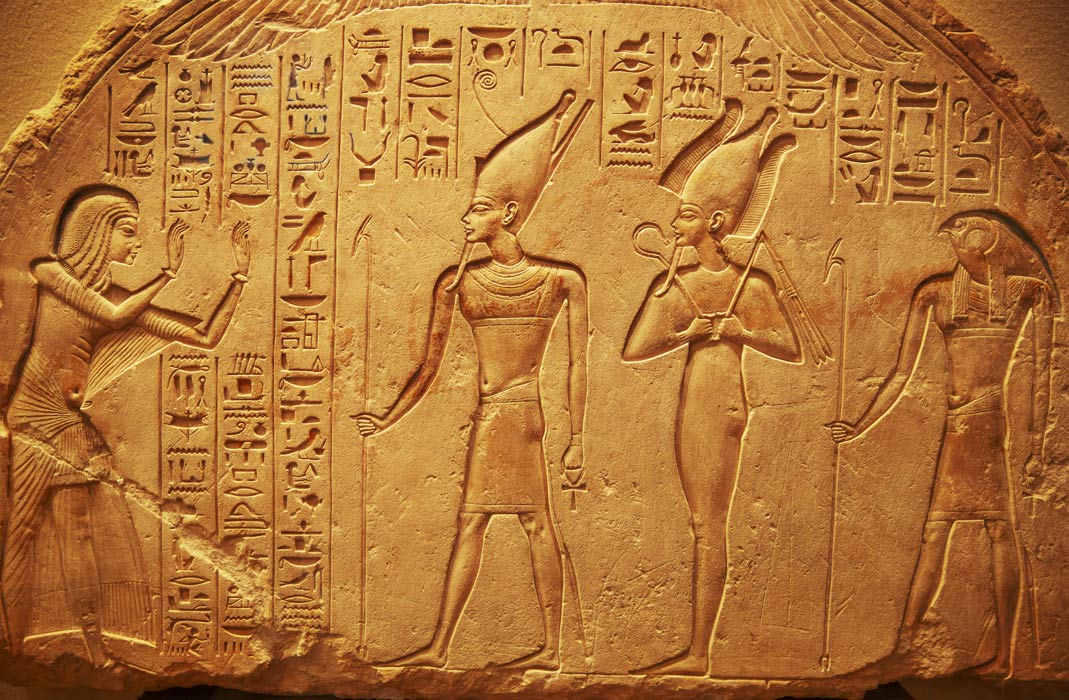Professor Gary A. Rendsburg gave this week’s ANELC eLecture on ancient Near Eastern linguistic connections between Egyptian and ancient Hebrew. The lecture flowed naturally from last week’s, given on linguistic connections between Afroasiatic languages. While Dr. Aaron Rubin gave a detailed analysis of shared linguistic features, Dr. Rendsburg looked at specific words and phrases which had crossed into the texts of each language grouping.
Dr. Rendsburg began with a review of the four scripts of Egypt: Hieroglyphic, Hieratic, Demotic, and Coptic. He provided a detailed summary of where these languages have been attested. This included Egyptian inscriptions in the Late Bronze Age, where its use crosses proto-Semitic evidence, which he referred to as Canaanite or Hebrew interchangeably.
Moving very quickly through slides that detailed inscriptions, texts, and their translations, he covered a great many instances where it appeared Egyptian terms were borrowed into Semitic literature, and where Semitic words and phrases had been adopted by Egyptian use. The presentation was a clear testimonial to a literary relationship between the two ancient societies.
Rendsburg’s study noted a much larger corpus of Semitic words coming into Egyptian than the other way around. Some of the Egyptian texts that Rendsburg described as containing influence from Semitic loanwords included the Merneptah stele, the Tale of Sinuhe, the Amarna letters, and other various inscriptions and writings. He presented a case that suggested the many Semitic immigrants who came to Egypt in the New Kingdom brought their language with them. His case was built on the observation that Semitic words suddenly appeared in Egyptian texts after the Middle Kingdom. This suggests that words previously unknown to Egyptian scribes came into use about the same time that Semitic language speaking immigrants came to Egypt.
Working in the other direction, Rendsburg pointed out a number of occurrences of Egyptian words used in Hebrew texts, with particular focus on the Hebrew Bible. Aside from some shared literary features, like the textual parallel of seven species in the Tale of Sinuhe and in Deuteronomy 8, Rendsburg noted several Egyptian words which had seemingly been adopted into Hebrew. Some words were from the royal court, like ‘Pharaoh’ (parʿo) and ‘chiefs’ (ḥarṭummim). Other words had to do with the Nile (yĕʾor), like ‘reeds’ (sup) and ‘papyrus’ (gomeʾ). Other loanwords included measurements, gems, jewelry, and containers, items conceivably specific to Egyptian culture and borrowed into Hebrew use.
One container with an Egyptian name is the word used for Moses’ basket in the Hebrew Bible book of Exodus. The word is often translated ‘ark’ in English. The Hebrew word is teba. According to Dr. Rensburg’s presentation, the teba is the name of an Egyptian box used as a divine shrine, or a container for some divine item.
The term seems fitting to be used for the container that saved Moses from the dangers of the river. It is also the same word used for Noah’s ark in Genesis 6. Dr. Rendsburg made a point to say that in Rabbinic tradition Moses’s basket and Noah’s ark were referred to as a ‘Torah shrine’, or a container fit to hold the Torah (Mishna Berakhot 5.3). The apparent symbolism cannot be lost in that both of these arks served an important purpose of divine salvation for the ancient Israelites.
This week’s ANELC presentation on connections between Egyptian and Hebrew makes a strong case for an interdependent literary relationship between Semitic travelers and ancient Egyptian storytellers. The linguistic connections are apparent. However, the direction of such a relationship, or specific arrangement of their co-existence, is not clear. The presentation raised many questions about the state of Egyptian language in the New kingdom era and the growing influence of Semitic language use in the Near East.

Dr. Erica Mongé-Greer, holding a PhD in Divinity from the University of Aberdeen, is a distinguished researcher and educator specializing in Biblical Ethics, Mythopoeia, and Resistance Theory. Her work focuses on justice in ancient religious texts, notably reinterpreting Psalm 82’s ethics in the Hebrew Bible, with her findings currently under peer review.
In addition to her academic research, Dr. Mongé-Greer is an experienced University instructor, having taught various biblical studies courses. Her teaching philosophy integrates theoretical discussions with practical insights, promoting an inclusive and dynamic learning environment.
Her ongoing projects include a book on religious themes in the series Battlestar Galactica and further research in biblical ethics, showcasing her dedication to interdisciplinary studies that blend religion with contemporary issues.




